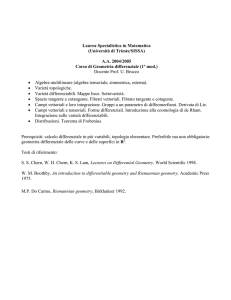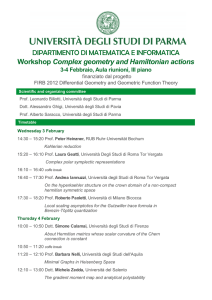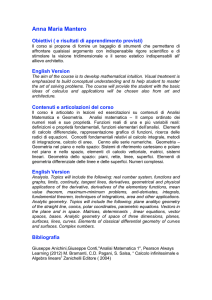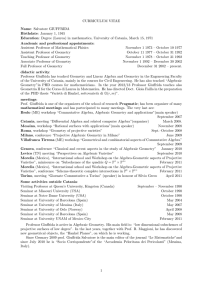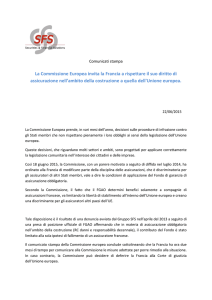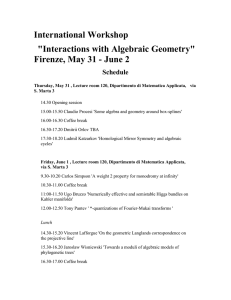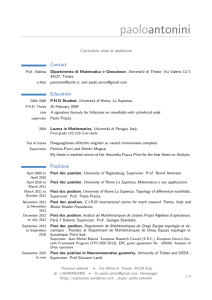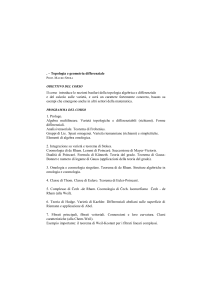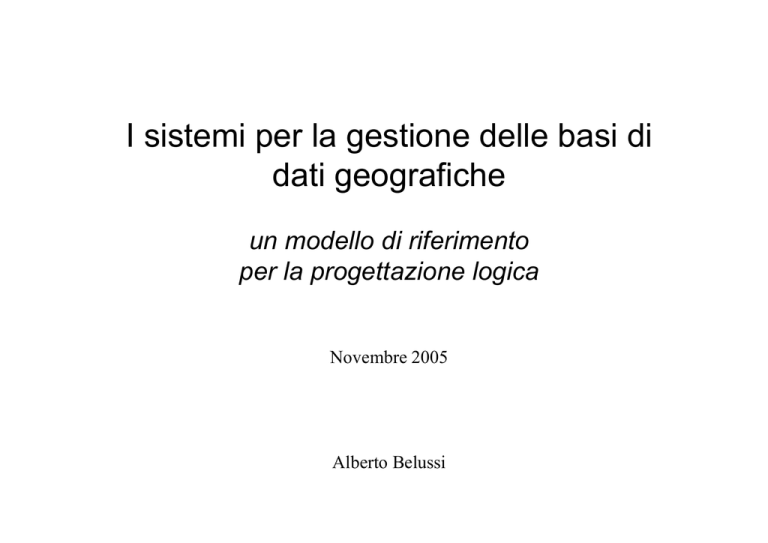
I sistemi per la gestione delle basi di
dati geografiche
un modello di riferimento
per la progettazione logica
Novembre 2005
Alberto Belussi
Sistemi per la Gestione di Basi di
Dati Geografiche
Premessa
• Consideriamo il modello relazionale come modello di
riferimento per i sistemi che gestiscono basi di dati
tradizionali.
• La componente geometrica del dato geografico non può
essere rappresentata nel modello relazionale utilizzando
un insieme di attributi di tipo numerico che contengano
coordinate, in quanto:
1.
2.
3.
I metodi tradizionali per l'accesso ai dati (indici) non sono
adeguati per le interrogazioni spaziali,
l'utente non e' in grado di interagire con un'interfaccia che spezza
i valori geometrici in coordinate semplici,
non esiste supporto alle interrogazioni spaziali.
Sistemi per la Gestione di Basi di
Dati Geografiche
• Un sistema per la gestione di basi di dati basato sul
paradigma Object-Oriented non può essere adottato per due
motivi:
– le prestazioni di questi sistemi sono ancora insufficienti per
questo tipo di applicazioni,
– l'integrazione con basi di dati relazionali è difficoltosa.
Soluzione attuale
Sistemi dedicati al dato geografico (Geo-DBMS) o sistemi
tradizionali (DBMS ) con estensioni specifiche per la gestione
del dato geografico.
Tali sistemi adottano un modello dei dati geo-relazionale.
Geo-DBMS
Definizione di Geo-DBMS secondo Güting (1994):
• un sistema per la gestione di dati geografici (Geo-DBMS) e’
innanzitutto un sistema per la gestione di dati (DBMS);
• esso offre tipi predefiniti (Spatial Data Types - SDT) per
rappresentare il dato geografico nello schema e per trattare il
dato geografico nel linguaggio di interrogazione;
• esso offre un’implementazione dei dati geografici che include
almeno l'accesso ai dati geometrici attraverso un indice spaziale
e un algoritmo efficiente per l’operazione di join spaziale.
Il modello dei dati di un
Geo-DBMS
La maggior parte degli attuali Geo-DBMS adotta un modello dei
dati geo-relazionale.
Tale modello è un'estensione del modello relazionale che presenta
domini e operatori specifici per rappresentare e manipolare il dato
geografico.
Quali estensioni sono necessarie
al modello relazionale per trattare il dato geografico?
1. Introduzione di tipi specifici per rappresentare il dato
spaziale.
2. Estensione del linguaggio di interrogazione per esprimere
condizioni di selezione basate su proprietà spaziali.
Modelli dei dati esistenti
•
•
•
•
OpenGIS Simple Features Specification
For SQL
Modello dei dati di Oracle 10g
Modello dei dati di ESRI Shapefile
Modello dei dati di ESRI GeoDatabase
OpenGIS Simple Features
Specification For SQL (SFS)
• Hanno contribuito alla sua definizione: ESRI Inc., IBM
Corporation, Informix Software Inc., MapInfo
Corporation, Oracle Corporation.
• Ultima versione: OpenGIS Project Document 99-049
Release Date: May 5, 1999.
Di seguito descriviamo nel dettaglio il modello.
SFS :Feature Tables
Simple geospatial feature collections will conceptually be
stored as tables with geometry valued columns in a Relational
DBMS (RDBMS), each feature will be stored as a row in a
table.
The non-spatial attributes of features will be mapped onto
columns whose types are drawn from the set of standard
SQL92 data types.
The spatial attributes of features will be mapped onto columns
whose SQL data types are based on the underlying concept of
additional geometric data types for SQL. A table whose rows
represent Open GIS features shall be referred to as a feature
table.
SFS :Feature Tables
Feature table implementations are described for two
target SQL environments: SQL92 and SQL92 with
Geometry Types.
We consider only the SQL92 with Geometry Types
implementation.
The term SQL92 with Geometry Types is used to
refer to a SQL92 environment that has been
extended with a set of Geometry Types.
SFS: Geometry Object Model
SFS: Geometry class
Geometry is the root class of the hierarchy.
Geometry is an abstract (non-instantiable) class.
The instantiable subclasses of Geometry are
restricted to 0, 1 and two-dimensional geometric
objects that exist in two-dimensional coordinate
space (ℜ2).
All instantiable geometry classes are defined so that
valid instances of a geometry class are topologically
closed (i.e. all defined geometries include their
boundary).
SFS: basic methods on Geometry
GeometryType ( ):String —Returns the name of the
instantiable subtype of Geometry of which this Geometry
instance is a member.
Dimension ( ):Integer—The inherent dimension of this
Geometry object, which must be less than or equal to the
coordinate dimension.
SRID ( ):Integer—Returns the Spatial Reference System ID
for this Geometry.
Envelope( ):Geometry—The minimum bounding box for this
Geometry.
SFS: basic methods on Geometry
AsText( ):String —Exports this Geometry to a specific wellknown text representation of Geometry.
AsBinary( ):Binary—Exports this Geometry to a specific
well-known binary representation of Geometry.
IsEmpty( ):Integer —Returns 1 (TRUE) if this Geometry is
the empty geometry . If true, then this Geometry represents
the empty point set, ∅, for the coordinate space.
IsSimple( ):Integer —Returns 1 (TRUE) if this Geometry has
no anomalous geometric points, such as self intersection or
self tangency.
SFS: basic methods on Geometry
Boundary( ):Geometry —Returns the closure of the
combinatorial boundary of this Geometry.
Distance(anotherGeometry:Geometry):Double—Returns the
shortest distance between any two points in the two
geometries as calculated in the spatial reference system of this
Geometry.
Buffer(distance:Double):Geometry—Returns a geometry that
represents all points whose distance from this Geometry is
less than or equal to distance. Calculations are in the Spatial
Reference System of this Geometry.
SFS: basic methods on Geometry
ConvexHull( ):Geometry—Returns a geometry that
represents the convex hull of this Geometry.
Intersection(anotherGeometry:Geometry):Geometry—
Returns a geometry that represents the point set intersection
of this Geometry with anotherGeometry.
Union(anotherGeometry:Geometry):Geometry—Returns a
geometry that represents the point set union of this Geometry
with anotherGeometry.
Difference(anotherGeometry:Geometry):Geometry—Returns
a geometry that represents the point set difference of this
Geometry with anotherGeometry.
SymDifference(anotherGeometry:Geometry):Geometry—
Returns a geometry that represents the point set symmetric
difference of this Geometry with anotherGeometry.
SFS: Geometric collection
A GeometryCollection is a geometry that is a collection of 1
or more geometries.
All the elements in a GeometryCollection must be in the same
Spatial Reference. This is also the Spatial Reference for the
GeometryCollection.
Methods:
NumGeometries( ):Integer—Returns the number of
geometries in this GeometryCollection.
GeometryN(N:integer):Geometry—Returns the Nth
geometry in this GeometryCollection.
SFS: Point
A Point is a 0-dimensional geometry and represents
a single location in coordinate space. A Point has a
x-coordinate value and a y-coordinate value.
The boundary of a Point is the empty set.
Methods:
X( ):Double —The x-coordinate value for this Point.
Y( ):Double —The y-coordinate value for this Point.
SFS: Multipoint
A MultiPoint is a 0 dimensional geometric collection.
The elements of a MultiPoint are restricted to Points.
The points are not connected or ordered.
A MultiPoint is simple if no two Points in the
MultiPoint are equal (have identical coordinate
values).
The boundary of a MultiPoint is the empty set.
SFS: Curve
A Curve is a one-dimensional geometric object usually
stored as a sequence of points, with the subtype of Curve
specifying the form of the interpolation between points.
This specification defines only one subclass of Curve,
LineString, which uses linear interpolation between
points.
Topologically a Curve is a one-dimensional geometric
object that is the homeomorphic image of a real, closed,
interval
D = [a, b] = {x ∈ R a <= x <= b}
under a mapping
f:[a,b] → ℜ2
SFS: Curve properties
• A Curve is simple if it does not pass through the
same point twice.
• A Curve is closed if its start point is equal to its
end point.
• The boundary of a closed Curve is empty.
• A Curve that is simple and closed is a Ring.
• The boundary of a non-closed Curve consists of
its two end points.
• A Curve is defined as topologically closed.
SFS: Curve Methods
• Length( ):Double—The length of this Curve in its
associated spatial reference.
• StartPoint( ):Point—The start point of this Curve.
• EndPoint( ):Point—The end point of this Curve.
• IsClosed( ):Integer—Returns 1 (TRUE) if this
Curve is closed (StartPoint ( ) = EndPoint ( )).
• IsRing( ):Integer—Returns 1 (TRUE) if this Curve
is closed (StartPoint ( ) = EndPoint ( )) and this
Curve is simple (does not pass through the same
point more than once).
SFS: LineString, Line,
LinearRing
A LineString is a Curve with linear
interpolation between points. Each consecutive
pair of points defines a line segment.
A Line is a LineString with exactly 2 points.
A LinearRing is a LineString that is both
closed and simple.
SFS: LineString, Line,
LinearRing (examples)
SFS: LineString methods
• NumPoints( ):Integer—The number of
points in this LineString.
• PointN(N:Integer):Point—Returns the
specified point N in this Linestring.
SFS: MultiCurve
A MultiCurve is a one-dimensional GeometryCollection
whose elements are Curves.
MultiCurve is a non-instantiable class.
A MultiCurve is simple if and only if all of its elements
are simple, the only intersections between any two
elements occur at points that are on the boundaries of
both elements.
A MultiCurve is closed if all of its elements are closed.
A MultiCurve is defined as topologically closed.
SFS: MultiCurve
The boundary of a MultiCurve is obtained by applying
the ‘mod 2’ union rule: a point is in the boundary of a
MultiCurve if it is in the boundaries of an odd number
of elements of the MultiCurve.
Methods:
IsClosed( ):Integer—Returns 1 (TRUE) if this
MultiCurve is closed (StartPoint ( ) = EndPoint ( ) for
each curve in this MultiCurve)
Length( ):Double—The Length of this MultiCurve
which is equal to the sum of the lengths of the element
Curves.
SFS: MultiCurve examples
SFS: Surface
A Surface is a two-dimensional geometric object.
The OpenGIS Abstract Specification defines a simple
Surface as consisting of a single ‘patch’ that is
associated with one ‘exterior boundary’ and 0 or more
‘interior’ boundaries.
The boundary of a simple Surface is the set of closed
curves corresponding to its ‘exterior’ and ‘interior
boundaries.
The only instantiable subclass of Surface defined in
this specification, Polygon, is a simple Surface that is
planar.
SFS: Surface methods
Area( ):Double—The area of this Surface, as
measured in the spatial reference system of this
Surface.
Centroid( ):Point—The mathematical centroid
for this Surface as a Point. The result is not
guaranteed to be on this Surface.
PointOnSurface( ):Point—A point guaranteed
to be on this Surface.
SFS: Polygon
A Polygon is a planar Surface, defined by 1
exterior boundary and 0 or more interior
boundaries.
Polygons are topologically closed.
The boundary of a Polygon consists of a set of
LinearRings that make up its exterior and
interior boundaries.
The interior of every Polygon is a connected
point set.
SFS: Polygon examples
SFS: Polygon examples
SFS: Polygon methods
ExteriorRing( ):LineString—Returns the
exterior ring of this Polygon.
NumInteriorRing( ):Integer—Returns the
number of interior rings in this Polygon.
InteriorRingN(N:Integer):LineString—Returns
the Nth interior ring for this Polygon as a
LineString.
SFS: MultiSurface
A MultiSurface is a two-dimensional geometric
collection whose elements are surfaces.
The interiors of any two surfaces in a MultiSurface
may not intersect.
The boundaries of any two elements in a MultiSurface
may intersect at most at a finite number of points.
MultiSurface is a non-instantiable class in this
specification.
The instantiable subclass of MultiSurface is
MultiPolygon, corresponding to a collection of
Polygons.
SFS: MultiSurface methods
Area( ):Double—The area of this MultiSurface,
as measured in the spatial reference system of
this MultiSurface.
Centroid( ):Point—The mathematical centroid
for this MultiSurface. The result is not
guaranteed to be on this MultiSurface.
PointOnSurface( ):Point—A Point guaranteed
to be on this MultiSurface.
SFS: MultiPolygon
A MultiPolygon is a MultiSurface whose
elements are Polygons..
The boundary of a MultiPolygon is a set of
closed curves (LineStrings) corresponding to
the boundaries of its element Polygons.
Each Curve in the boundary of the
MultiPolygon is in the boundary of exactly 1
element Polygon, and every Curve in the
boundary of an element Polygon is in the
boundary of the MultiPolygon.
SFS: MultiPolygon example
SFS: Relational Operators
Equals(anotherGeometry:Geometry):Integer
Returns 1 (TRUE) if this Geometry is ‘spatially equal’ to
anotherGeometry.
Disjoint(anotherGeometry:Geometry):Integer
Returns 1 (TRUE) if this Geometry is ‘spatially disjoint’
from anotherGeometry.
Touches(anotherGeometry:Geometry):Integer
Returns 1 (TRUE) if this Geometry ‘spatially touches’
anotherGeometry.
Overlaps(anotherGeometry:Geometry):Integer
Returns 1 (TRUE) if this Geometry ‘spatially overlaps’
anotherGeometry.
SFS: Relational Operators
Within(anotherGeometry:Geometry):Integer
Returns 1 (TRUE) if this Geometry is ‘spatially within’
anotherGeometry.
Contains(anotherGeometry:Geometry):Integer
Returns 1 (TRUE) if anotherGeometry is ‘spatially within’
this Geometry.
Crosses(anotherGeometry:Geometry):Integer
Returns 1 (TRUE) if this Geometry ‘spatially crosses’
anotherGeometry.
Intersects(anotherGeometry:Geometry):Integer
Returns 1 (TRUE) if this Geometry is ‘not spatially
disjoint’ from anotherGeometry.
SFS: Relational Operators
Relate(anotherGeometry:Geometry,
intersectionPatternMatrix:String):Integer
Returns 1 (TRUE) if this Geometry is spatially related to
anotherGeometry, by testing for intersections between the
Interior, Boundary and Exterior of the two geometries.
The pattern matrix consists of a set of 9 pattern-values,
one for each cell p in the matrix. The possible pattern
values p are {T, F, *, 0, 1, 2}.
For example:
overlapMatrix = ‘T*T***T**’;
Components of a
GeoRelational-database
A GeoRelational-database is composed of:
– The Spatial Reference Systems table, which is named
SPATIAL_REF_SYS, stores information on each spatial reference
system used in the database.
– The Geometric Columns Metadata table or view, which is named
GEOMETRY_COLUMNS, provides metadata information on the
spatial reference for each geometry column in the database.
– The SQL Geometry Types extend the set of available SQL92 types
to include Geometry Types.
– A set of Feature Tables: each feature table is a table containing one
or more geometric attributes that are modeled using a column whose
type correspond to a SQL Geometry Type. Feature-to-feature
relations are defined as FOREIGN KEY references.
Components of a
GeoRelational-database
Spatial Reference Systems table
CREATE TABLE SPATIAL_REF_SYS
(
SRID INTEGER NOT NULL PRIMARY KEY,
AUTH_NAME VARCHAR (256),
AUTH_SRID INTEGER,
SRTEXT VARCHAR (2048)
)
Components of a
GeoRelational-database
Spatial Reference Systems table
Attributes:
• SRID: an integer value that uniquely identifies each
Spatial Reference System within a database.
• AUTH_NAME—the name of the standard or
standards body that is being cited for this reference
system. EPSG would be a valid AUTH_NAME
• AUTH_SRID—the ID of the Spatial Reference
System as defined by the Authority cited in
AUTH_NAME.
• SRTEXT—The Well-known Text representation of
the Spatial Reference System.
Components of a
GeoRelational-database
Geometric Columns Metadata table or view
CREATE TABLE GEOMETRY_COLUMNS (
F_TABLE_CATALOG VARCHAR(256) NOT NULL,
F_TABLE_SCHEMA VARCHAR(256) NOT NULL,
F_TABLE_NAME VARCHAR(256) NOT NULL,
F_GEOMETRY_COLUMN VARCHAR(256) NOT NULL,
COORD_DIMENSION INTEGER,
SRID INTEGER REFERENCES SPATIAL_REF_SYS,
CONSTRAINT GC_PK PRIMARY KEY
(F_TABLE_CATALOG, F_TABLE_SCHEMA,
F_TABLE_NAME, F_GEOMETRY_COLUMN)
)
Components of a
GeoRelational-database
Geometric Columns Metadata table or view
Attributes:
– F_TABLE_CATALOG, F_TABLE_SCHEMA,
F_TABLE_NAME: the fully qualified name of the
feature table containing the geometry column.
– F_GEOMETRY_COLUMN: the name of the geometry
column in the feature table.
– COORD_DIMENSION: the coordinate dimension for
the geometry values in this column, which will be equal
to the number of dimensions in the spatial reference
system.
– SRID: the ID of the spatial reference system used for the
coordinate geometry in this table. It is a foreign key
reference to the SPATIAL_REFERENCES table.
Components of a
GeoRelational-database
SQL Geometry Types
Geometry, Point, Curve, LineString, Surface,
Polygon, GeomCollection, MultiPoint , MultiCurve,
MultiLineString, MultiSurface, MultiPolygon
Components of a
GeoRelational-database
Feature Tables
CREATE TABLE <feature-name>
(
<FID name> <FID type>,
<feature attributes> <other FID type> REFERENCES <other feature
view>,
…(other attributes for feature)
<geometry attribute 1> <Geometry type>,
… (other geometric attributes for feature)
PRIMARY KEY <FID name>,
FOREIGN KEY <FID relation name> REFERENCES <FEATURE
table> <other FID name>
….
Components of a
GeoRelational-database
Feature Tables (continua)
CONSTRAINT SRS_1 CHECK (SRID(<geometry attribute 1>) in
(SELECT SRID from GEOMETRY_COLUMNS where
F_TABLE_CATALOG = <catalog> and F_TABLE_SCHEMA =
<schema> and F_TABLE_NAME = <feature-name> and
F_GEOMETRY_COLUMN = <geometry attribute 1>))
... (spatial reference constraints for other geometric attributes)
)
SQL Textual Representation
of Geometry (examples)
Well-known Text
Representation of SRS
A spatial reference system, also referred to as a coordinate system, is
a geographic (latitude-longitude), a projected (X,Y), or a geocentric
(X,Y,Z) coordinate system.
The coordinate system is composed of several objects.
Well-known Text
Representation of SRS
Un modello logico/fisico per
Geo-DBMS
La rappresentazione di insiemi di valori geometrici
in un Geo-DBMS
Metodo 1: insiemi di liste di coordinate
Esempio
G3
G2
G1
G1 = (ln, (<0,0>,<1,2>,<5,1>,<9,2>,<0,17>))
G2 = (ln, (<-2.5,3>,<1,2>,<5,1>,<9,2>,<9.1,17.5>))
G3 = (pg, (<1,2>,<5,1>,<9,2>,<11,3.5>,<10,4.5>,<5.3,5>,<3.5,4.5>,<0,3.2>))
Un modello logico/fisico per
Geo-DBMS
La rappresentazione di insiemi di valori geometrici
in un Geo-DBMS
Metodo 1: insiemi di liste di coordinate
Vantaggi:
1. Indipendenza tra i valori geometrici ⇒ facilità di inserimento di nuovi
valori geometrici. Verifica vincoli spaziali a posteriori.
2. Buone prestazioni dell'operazione di visualizzazione grafica della
geometria di un sottoinsieme limitato di valori.
Svantaggi:
1. Tutte le selezioni spaziali richiedono l'applicazione di algoritmi di
geometria computazionale.
2. Tutte le operazioni di manipolazione (ad esempio il calcolo di
intersezioni) richiede algoritmi di geometria computazionale.
3. Ridondanza nella rappresentazione della geometria.
Un modello logico/fisico per
Geo-DBMS
Modelli dei dati che adottano una
rappresentazione indipendente degli oggetti
geometrici:
– Modello dei dati base di ORACLE 10g
– Modello dei dati di ArcView/GeoDatabase
(ESRI)
– Modello dei dati di PostGIS (estensione di
Postgresql per i dati geografici)
Un modello logico/fisico per
Geo-DBMS
La rappresentazione di insiemi di valori geometrici in un Geo-DBMS
Metodo 2: struttura basata su strutture topologiche (geometria condivisa)
Esempio
a6
P1
G3
a1
G1
P2
a4
P3
G2
a3
P4
a2
a5
P6
P5
G1 = {L, (a1, a2, a3)}; G2 = {L, (a4, a2, a5)}; G3 = {L, (a2, a6)};
a1 = (P1, (), P3); a2 = (P3, (<5,1>), P4); a3 = (P4, (), P6) ….
P1 = <-2.5,3>; P2 = <0,0>; P3 = <1,2> ...
Un modello logico/fisico per
Geo-DBMS
La rappresentazione dei valori geometrici in un Geo-DBMS
Metodo 2: struttura basata su strutture topologiche (geometria condivisa)
Vantaggi:
• Eliminazione della ridondanza nella rappresentazione della geometria.
• Riduzione di alcune operazioni geometriche a selezione di un insieme di
identificatori o puntatori a valori geometrici elementari precalcolati.
• Riduzione della ricerca via predicati topologici ad un confronto tra
identificatori o puntatori a valori geometrici elementari precalcolati.
• Verifica vincoli spaziali immediata e supportata dalla struttura
topologica.
Svantaggi:
• Ripristino della topologia corretta a valle di ogni inserimento di un nuovo
valore geometrico.
• La pura visualizzazione di un valore geometrico richiede il ritrovamento
della geometria attraverso una catena di puntatori.
Un modello logico/fisico per
Geo-DBMS
Modelli dei dati che consentono di organizzare
in strutture topologiche gli attributi geometrici
di un insieme di tabelle:
– Modello dei dati avanzato di ORACLE 10g
– Modello dei dati di Arc/Info (ESRI)
– Modello di Radius Topology (Laser-Scan)
Un modello logico/fisico per
Geo-DBMS
Riepilogo dei costrutti del modello geo-relazionale
Domini di base
Domini SQL92 + SQL Geometry Types di Simple Feature
Specification
Relazione (tabella)
è un costruttore di tipo per tuple, dove gli attributi hanno
come dominio un dominio di base.
Strato topologico
è una struttura dati per la rappresentazione integrata di
insiemi di valori geometrici di uno o più tipi (geometria
condivisa).
Un modello logico/fisico per
Geo-DBMS
Vincoli tra strati topologici e attributi geometrici in
uno schema:
– ogni strato presente in uno schema contiene solo i valori
geometrici di uno o più attributi geometrici appartenenti a
relazioni dello schema.
– i valori di un attributo geometrico sono contenuti al massimo
in uno e un sol strato.
Da ciò deriva che:
– in uno schema che presenti relazioni (tabelle) con attributi
geometrici, va indicata dove presente la corrispondenza
attributo geometrico/strato topologico.
Un modello logico/fisico per
Geo-DBMS
Esempio di schema logico/fisico di una base di dati geografica
Relazioni
BOSCO (Tipo: STRING, Pg: MULTIPOLYGON)
PRATO (Pascolo: BOOLEAN, Pg: MULTIPOLYGON)
Strati topologici
S_MONTAGNA (MULTIPOLYGON)
Mapping Attributi geometrici/Strati topologici
BOSCO.Pg →
PASCOLO.Pg →
S_MONTAGNA
S_MONTAGNA
Un modello logico/fisico per
Geo-DBMS
Esempio di istanza di una base di dati geografica
BOSCO
Tipo
Pg
Ceduo
23,44
Latifoglia 8,44
S_MONTAGNA
PRATO
Pascolo
True
False
44
23
Pg
14,9
2
8
9
14
2

